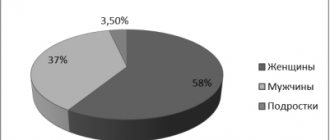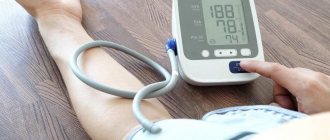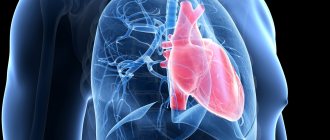Arterial hypertension
Symptomatic arterial hypertension is a secondary hypertensive condition that develops as a result of pathology of the organs that regulate blood pressure. Symptomatic arterial hypertension is distinguished by its persistent course and resistance to antihypertensive therapy, the development of pronounced changes in target organs (heart and kidney failure, hypertensive encephalopathy, etc.). Determining the causes of arterial hypertension requires ultrasound, angiography, CT, MRI (kidneys, adrenal glands, heart, brain), studies of biochemical parameters and blood hormones, and blood pressure monitoring. Treatment consists of medication or surgery to address the underlying cause.
Arterial hypertension
Unlike independent essential (primary) hypertension, secondary arterial hypertension serves as symptoms of the diseases that cause them. Arterial hypertension syndrome accompanies the course of over 50 diseases. Among the total number of hypertensive conditions, the proportion of symptomatic arterial hypertension is about 10%. The course of symptomatic arterial hypertension is characterized by signs that allow them to be differentiated from essential hypertension (hypertension):
- The age of patients is up to 20 years and over 60 years;
- Sudden development of arterial hypertension with persistently high blood pressure levels;
- Malignant, rapidly progressing course;
- Development of sympathoadrenal crises;
- A history of etiological diseases;
- Poor response to standard therapy;
- Increased diastolic pressure in renal arterial hypertension.
Read also
Diabetes mellitus, type 2
Diabetes mellitus (DM) is a group of metabolic diseases characterized by chronic hyperglycemia, which results from impaired insulin secretion, insulin action, or both...
Read more
Diffuse nodular goiter, autoimmune thyroiditis, hypothyroidism
Chronic autoimmune thyroiditis, hypothyroidism, thyroid nodules. Thyroid diseases are a common problem in iodine-deficient regions (which include Samara...
More details
Osteoporosis
Osteoporosis is a progressive metabolic disease of the skeletal bones, which results in a decrease in bone density and disruption of its internal structure. The result of osteoporosis is...
More details
Metabolic syndrome
Metabolic syndrome is a “pandemic of the 21st century.” The prevalence of metabolic syndrome is 20–40%. In the Russian Federation, 40% of the population have 2 components of metabolic syndrome, 11% –...
More details
Hyperprolactinemia
Hyperprolactinemia is a persistent increase in the level of the hormone prolactin in the blood. Hyperprolactinemia syndrome is a complex of symptoms that occur against the background of increased prolactin levels, the most characteristic...
More details
Classification of symptomatic arterial hypertension
According to the primary etiological link, symptomatic arterial hypertension is divided into:
- Neurogenic (caused by diseases and lesions of the central nervous system):
- central (traumas, brain tumors, meningitis, encephalitis, stroke, etc.)
- peripheral (polyneuropathies)
- Nephrogenic (renal):
- interstitial and parenchymal (chronic pyelonephritis, glomerulonephritis, amyloidosis, nephrosclerosis, hydronephrosis, systemic lupus erythematosus, polycystic disease)
- renovascular (atherosclerosis, renal vascular dysplasia, vasculitis, thrombosis, renal artery aneurysms, tumors compressing the renal vessels)
- mixed (nephroptosis, congenital anomalies of the kidneys and blood vessels)
- renoprinic (condition after kidney removal)
- Endocrine:
- adrenal (pheochromocytoma, Conn's syndrome, adrenal hyperplasia)
- thyroid (hypothyroidism, thyrotoxicosis) and parathyroid
- pituitary (acromegaly, Itsenko-Cushing's disease)
- menopausal
- Hemodynamic (caused by damage to the great vessels and heart):
- aortosclerosis
- stenosis of the vertebrobasilar and carotid arteries
- caorctation of the aorta
- aortic valve insufficiency
- Dosage forms when taking mineralo- and glucocorticoids, progesterone- and estrogen-containing contraceptives, levothyroxine, heavy metal salts, indomethacin, licorice powder, etc.
Depending on the magnitude and persistence of blood pressure, the severity of left ventricular hypertrophy, and the nature of changes in the fundus, 4 forms of symptomatic arterial hypertension are distinguished: transient, labile, stable and malignant.
Transient arterial hypertension is characterized by an unstable increase in blood pressure, changes in the fundus vessels are absent, and left ventricular hypertrophy is practically undetectable. With labile arterial hypertension, there is a moderate and unstable increase in blood pressure that does not decrease on its own. There is mild hypertrophy of the left ventricle and narrowing of retinal vessels.
Stable arterial hypertension is characterized by persistent and high blood pressure, myocardial hypertrophy and pronounced vascular changes in the fundus (angioretinopathy I - II degrees). Malignant arterial hypertension is distinguished by sharply increased and stable blood pressure (especially diastolic > 120-130 mm Hg), sudden onset, rapid development, and the risk of severe vascular complications from the heart, brain, and fundus, which determine an unfavorable prognosis.
Forms of symptomatic arterial hypertension
Nephrogenic parenchymal arterial hypertension
Most often, symptomatic arterial hypertension is of nephrogenic (renal) origin and is observed in acute and chronic glomerulonephritis, chronic pyelonephritis, polycystic and hypoplastic kidneys, gouty and diabetic nephropathy, trauma and kidney tuberculosis, amyloidosis, SLE, tumors, nephrolithiasis.
The initial stages of these diseases usually occur without arterial hypertension. Hypertension develops with severe damage to the tissue or apparatus of the kidneys. The features of renal arterial hypertension are predominantly the young age of patients, the absence of cerebral and coronary complications, the development of chronic renal failure, and the malignant nature of the course (in chronic pyelonephritis - in 12.2%, chronic glomerulonephritis - in 11.5% of cases).
In the diagnosis of parenchymal renal hypertension, ultrasound of the kidneys, urine examination are used (proteinuria, hematuria, cylindruria, pyuria, hyposthenuria - low specific gravity of urine), determination of creatinine and urea in the blood (azotemia is detected). To study the secretory-excretory function of the kidneys, isotope renography and urography are performed; additionally - angiography, ultrasound of renal vessels, MRI and CT of the kidneys, kidney biopsy.
Nephrogenic renovascular (vasorenal) arterial hypertension
Renovascular or vasorenal arterial hypertension develops as a result of unilateral or bilateral disturbances of arterial renal blood flow. In 2/3 of patients, the cause of renovascular arterial hypertension is atherosclerotic damage to the renal arteries. Hypertension develops when the lumen of the renal artery narrows by 70% or more. Systolic blood pressure is always above 160 mm Hg, diastolic blood pressure is always above 100 mm Hg.
Renovascular arterial hypertension is characterized by a sudden onset or sharp worsening of the course, insensitivity to drug therapy, and a high proportion of malignant course (in 25% of patients).
Diagnostic signs of vasorenal arterial hypertension are: systolic murmurs over the projection of the renal artery, determined by ultrasonography and urography - a decrease in one kidney, a slowdown in the removal of contrast. Ultrasound shows echoscopic signs of asymmetry in the shape and size of the kidneys, exceeding 1.5 cm. Angiography reveals a concentric narrowing of the affected renal artery. Duplex ultrasound scanning of the renal arteries determines a violation of the main renal blood flow.
In the absence of treatment for renovascular arterial hypertension, the 5-year survival rate of patients is about 30%. The most common causes of death in patients: cerebral strokes, myocardial infarction, acute renal failure. In the treatment of vasorenal arterial hypertension, both drug therapy and surgical techniques are used: angioplasty, stenting, traditional operations.
With significant stenosis, long-term use of drug therapy is unjustified. Drug therapy produces a short-term and inconsistent effect. The main treatment is surgical or endovascular. For vasorenal arterial hypertension, an intravascular stent is installed to expand the lumen of the renal artery and prevent its narrowing; balloon dilatation of a narrowed section of a vessel; reconstructive interventions on the renal artery: resection with anastomosis, prosthetics, vascular bypass anastomoses.
Pheochromocytoma
Pheochromocytoma, a hormone-producing tumor that develops from chromaffin cells of the adrenal medulla, accounts for 0.2% to 0.4% of all occurring forms of symptomatic arterial hypertension. Pheochromocytomas secrete catecholamines: norepinephrine, adrenaline, dopamine. Their course is accompanied by arterial hypertension, with periodically developing hypertensive crises. In addition to hypertension, pheochromocytomas cause severe headaches, increased sweating and palpitations.
Pheochromocytoma is diagnosed when an increased content of catecholamines is detected in the urine by performing diagnostic pharmacological tests (tests with histamine, tyramine, glucagon, clonidine, etc.). Ultrasound, MRI or CT scan of the adrenal glands allows you to clarify the location of the tumor. By performing a radioisotope scan of the adrenal glands, it is possible to determine the hormonal activity of pheochromocytoma, identify tumors of extra-adrenal localization, and metastases.
Pheochromocytomas are treated exclusively with surgery; before surgery, arterial hypertension is corrected with α- or β-adrenergic blockers.
Primary aldosteronism
Arterial hypertension in Conn's syndrome or primary hyperaldosteronism is caused by an aldosterone-producing adenoma of the adrenal cortex. Aldosterone promotes the redistribution of K and Na ions in cells, fluid retention in the body and the development of hypokalemia and arterial hypertension.
Hypertension is practically not amenable to drug correction; attacks of myasthenia gravis, convulsions, paresthesia, thirst, and nictruria are noted. Hypertensive crises with the development of acute left ventricular failure (cardiac asthma, pulmonary edema), stroke, and hypokalemic cardiac paralysis are possible.
Diagnosis of primary aldosteronism is based on determining plasma levels of aldosterone and electrolytes (potassium, chlorine, sodium). There is a high concentration of aldosterone in the blood and high excretion in the urine, metabolic alkalosis (blood pH - 7.46-7.60), hypokalemia (<3 mmol/l), hypochloremia, hypernatremia. When examining blood from the adrenal veins, a 2-3-fold increase in the level of aldosterone on the affected side is detected. Radioisotope studies and ultrasound scanning of the adrenal glands reveal an enlargement of the adrenal gland affected by aldosteroma or bilateral hyperplasia of the adrenal cortex.
For malignant arterial hypertension caused by aldosteroma, surgical treatment is performed to normalize or significantly reduce blood pressure in 50-70% of patients. Before surgery, a hyposodium diet is prescribed and treatment with an aldosterone antagonist, spironolactone, which relieves hypokalemia and arterial hypertension (25-100 mg every 8 hours).
Itsenko-Cushing's syndrome and disease
Endocrine arterial hypertension develops in 80% of patients with the disease and Cushing's syndrome. Hypertension is caused by hypersecretion of glucocorticoid hormones by the adrenal cortex (hypercortisolism) and is characterized by a stable, crisis-free course, resistance to antihypertensive therapy, and a proportional increase in systolic and diastolic blood pressure. Another characteristic manifestation of the disease is Cushingoid obesity.
With Itsenko-Cushing's syndrome/disease, the level of 11 and 17-OCS, corticotropin, and hydrocortisone increases in the blood. Excretion of 17-KS and 17-OX is increased in urine. For differential diagnosis between corticosteroma and pituitary adenoma, MRI and CT scanning of the adrenal glands, pituitary gland, ultrasound and radioisotope scanning of the adrenal glands, and a craniogram are performed. Treatment of hypercortisolism and the arterial hypertension caused by it can be medication, surgery or radiation.
Coarctation of the aorta
Coarctation of the aorta is a congenital malformation of the aorta, manifested by its segmental narrowing, which impedes systemic blood flow. Coarctation of the aorta is a rare form of hypertension.
With secondary arterial hypertension caused by coarctation of the aorta, there is a difference in blood pressure measured in the arms (high) and legs (normal or low), an increase in blood pressure at the age of 1-5 years and its stabilization after 15 years, weakening or absence of pulsation in the femoral arteries , increased cardiac impulse, systolic murmurs over the apex, base of the heart, and on the carotid arteries. Diagnosis of coarctation of the aorta is based on radiography of the lungs and chest organs, aortography, and echocardiography. If the degree of stenosis is severe, surgical treatment is performed.
Dosage forms of arterial hypertension
The development of medicinal forms of arterial hypertension can cause vascular spasm, increased blood viscosity, sodium and water retention, the effect of drugs on the renin-angiotensin system, etc. Intranasal drops and cold remedies containing adrenomimetics and sympathomimetics in their composition (pseudoephedrine, ephedrine , phenylephrine) may cause hypertension.
Taking non-steroidal anti-inflammatory drugs causes the development of arterial hypertension due to fluid retention and suppression of the synthesis of prostaglandins, which have a vasodilating effect. Oral contraceptives containing estrogens have a stimulating effect on the renin-angiotensin system and cause fluid retention. Secondary arterial hypertension develops in 5% of women using oral contraception.
The stimulating effect of tricyclic antidepressants on the sympathetic nervous system can cause the development of arterial hypertension. The use of glucocorticoids increases blood pressure due to increased vascular reactivity to angiotensin II.
To establish the cause and form of secondary arterial hypertension, the cardiologist needs a detailed collection of the patient’s medical history, analysis of the coagulogram, and determination of blood renin.
Neurogenic arterial hypertension
Arterial hypertension of the neurogenic type is caused by lesions of the brain or spinal cord due to encephalitis, tumors, ischemia, traumatic brain injury, etc. In addition to increased blood pressure, they are typically characterized by severe headaches and dizziness, tachycardia, sweating, salivation, vasomotor skin reactions, abdominal pain, nystagmus, convulsive seizures.
Diagnostics use angiography of cerebral vessels, CT and MRI of the brain, and EEG. Treatment of arterial hypertension of the neurogenic type is aimed at eliminating brain pathology.
Publications in the media
Symptomatic arterial hypertension (AH, secondary arterial hypertension) is secondary hypertension that occurs as a result of damage to organs and systems that regulate blood pressure. Statistical data. 5–10% of all cases of hypertension (according to specialized clinics, using complex and expensive research methods, secondary hypertension can be detected in 30–35% of patients).
Etiology
• Kidney diseases •• Acute and chronic glomerulonephritis and pyelonephritis •• Obstructive nephropathy •• Polycystic kidney disease •• Systemic connective tissue diseases (SLE, systemic scleroderma, etc.) •• Systemic vasculitis •• Diabetic nephropathy •• Hydronephrosis •• Congenital renal hypoplasia •• Kidney injuries •• Renin-secreting tumors •• Primary salt retention (eg, Liddle's syndrome).
• Iatrogenic hypertension caused by taking drugs and exogenous substances •• Nasal drops and medications for the common cold containing adrenomimetic or sympathomimetic agents (for example, ephedrine, pseudoephedrine, phenylephrine) - an increase in blood pressure is possible •• Oral contraceptives containing estrogens - hypertension develops approximately in 5% of women (mechanisms: stimulation of the renin-angiotensin system and fluid retention) •• NSAIDs (indomethacin, etc.) cause hypertension as a result of suppression of the synthesis of Pg, which has a vasodilating effect, and also due to fluid retention •• TADs can cause an increase in blood pressure from -due to stimulation of the sympathetic nervous system •• GCs cause an increase in blood pressure due to an increase in vascular reactivity to angiotensin II and norepinephrine, as well as as a result of fluid retention.
• Endocrine diseases •• Acromegaly •• Hypothyroidism •• Hyperthyroidism •• Itsenko-Cushing syndrome •• Aldosteronism •• Congenital adrenal hyperplasia •• Pheochromocytoma •• Extra-adrenal chromaffinoma.
• Vascular diseases •• Coarctation of the aorta and its main branches •• Renal artery stenosis (vasorenal hypertension) •• Takayasu's disease.
• Systolic cardiovascular hypertension •• Aortic valve insufficiency •• Aortic sclerosis •• Severe bradycardia (III degree AV block) •• Arteriovenous fistulas •• Patent ductus arteriosus.
• Complications of pregnancy - see Arterial hypertension during pregnancy.
• Neurological diseases •• Increased ICP •• Brain tumors •• Encephalitis •• Respiratory acidosis •• Sleep apnea •• Paralysis of the limbs •• Guillain-Barre syndrome.
Clinical manifestations - see Arterial hypertension.
• Evidence of secondary hypertension •• Kidney disease, urinary tract infection, bacteriuria, hematuria, proteinuria •• Abuse of analgesics (damage to the renal parenchyma) •• Use of various drugs or substances: oral contraceptives, nasal drops, cocaine, NSAIDs •• Sweating, headaches, agitation (pheochromocytoma) •• Muscle weakness and tetany (aldosteronism).
• Physical examination •• Signs of endocrine diseases accompanied by hypertension: hypothyroidism, thyrotoxicosis, Itsenko-Cushing syndrome, pheochromocytoma, acromegaly •• Palpation of peripheral arteries, auscultation of vessels, heart, chest, abdomen to exclude diseases of the aorta and renovascular hypertension.
Research methods
• Mandatory methods •• OAM •• Determination of creatinine content in blood plasma •• Determination of potassium, sodium, glucose, cholesterol in blood plasma •• ECG.
• Additional methods •• Determination of triglycerides, HDL cholesterol, and uric acid in blood plasma •• Hb and Ht •• Urine culture •• X-ray examination •• EchoCG •• Determination of renin, angiotensin, aldosterone, corticosteroids, catecholamines •• Aortography and renography •• MRI/CT.
Treatment
• Hypertension in obesity •• Normalization of body weight •• Drugs of choice - calcium channel blockers, ACE inhibitors, a-blockers. The use of direct vasodilators (promote fluid retention) and diuretics (aggravate dyslipidemia) is not recommended.
• Drug hypertension •• Cancellation of the drug that caused hypertension •• If hypertension persists or the need to continue taking the drug, despite its side effects, - an antihypertensive drug •• For hypertension caused by drugs with sympathomimetic properties (for example, ephedrine, MAO inhibitors) - b-blockers •• For hypertension caused by oral contraceptives, drugs that stimulate the renin-angiotensin system, causing fluid retention in the body - ACE inhibitors and diuretics •• For hypertension associated with taking GCs - b-blockers, ACE inhibitors and /or diuretics •• If there is no effect, other secondary or essential hypertension should be excluded.
• “Alcoholic” hypertension •• First of all, you need to stop drinking alcohol (complete ban). In some cases, only this measure (not always easy to implement) can lead to normalization of blood pressure or its reduction •• Persons who are unable to completely give up alcohol are recommended to limit their intake to 21 alcoholic drinks per week for men and to 14 alcoholic drinks for women (one dose of alcohol corresponds to 8–10 g of pure alcohol, 0.5 l of beer or 1 glass of wine) •• One of the methods for monitoring the cessation of alcohol intake is to determine the dynamics of the content of g-glutamyl transpeptidase and the average volume of erythrocytes •• The drugs of choice are clonidine , ACE inhibitors, b-blockers and, possibly, blockers of slow dihydropyridine calcium channels. When taking drugs and alcohol, one should remember about their interactions (for example, the combination of clonidine + alcohol), withdrawal syndrome of substances taken (both drugs and alcohol), about which the patient must be warned •• With the development of post-alcohol withdrawal syndrome, accompanied by hypertension, β-blockers are considered one of the effective means (in the absence of contraindications).
• Hypertension in endocrine pathology •• In case of pheochromocytoma and primary hyperaldosteronism caused by an adenoma or carcinoma of the adrenal glands, the issue of surgical treatment should first be considered. If surgical treatment for pheochromocytoma is impossible for one reason or another, a-blockers (doxazosin, prazosin) are usually used. You should remember about the possibility of developing orthostatic arterial hypotension when using drugs in this group. The use of b-blockers (especially non-selective ones) is not recommended, since they can increase blood pressure due to blocking b2-adrenergic receptors. Indications for the use of beta-blockers are considered to be various arrhythmias that complicate the course of pheochromocytoma. In this case, preference should be given to selective b1-blockers in combination with α-blockers •• For primary hyperaldosteronism caused by adrenal hyperplasia, spironolactone is most often used at a dose of 100–400 mg/day. If it is necessary to enhance the antihypertensive effect, hydrochlorothiazide or α-blockers can be added. There is evidence of the effectiveness of amlodipine •• For hypothyroidism, drugs of all groups are prescribed, with the exception of b-blockers.
Abbreviations. AH - arterial hypertension.
ICD-10 • I15 Secondary hypertension









